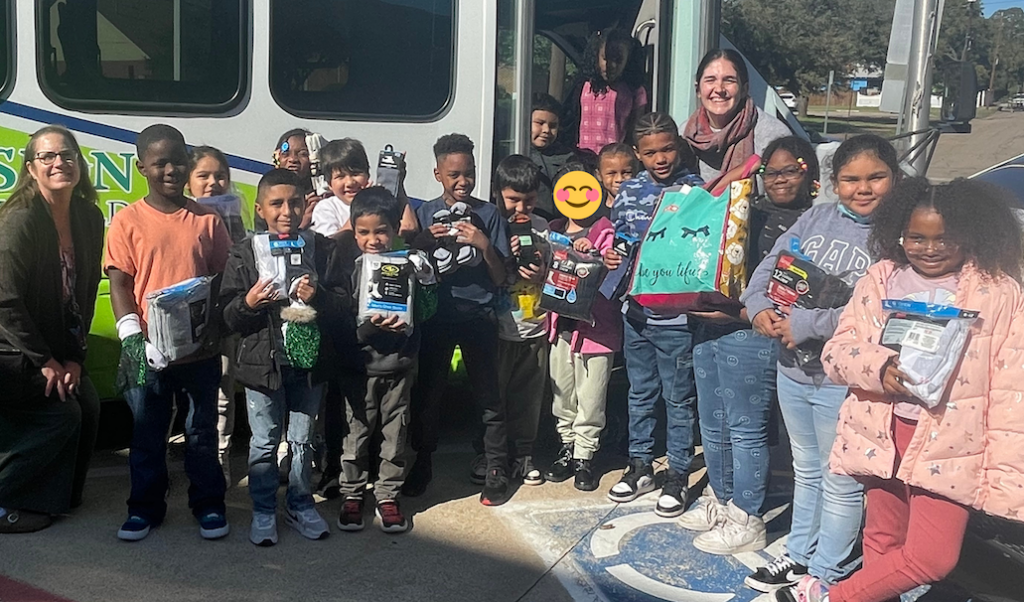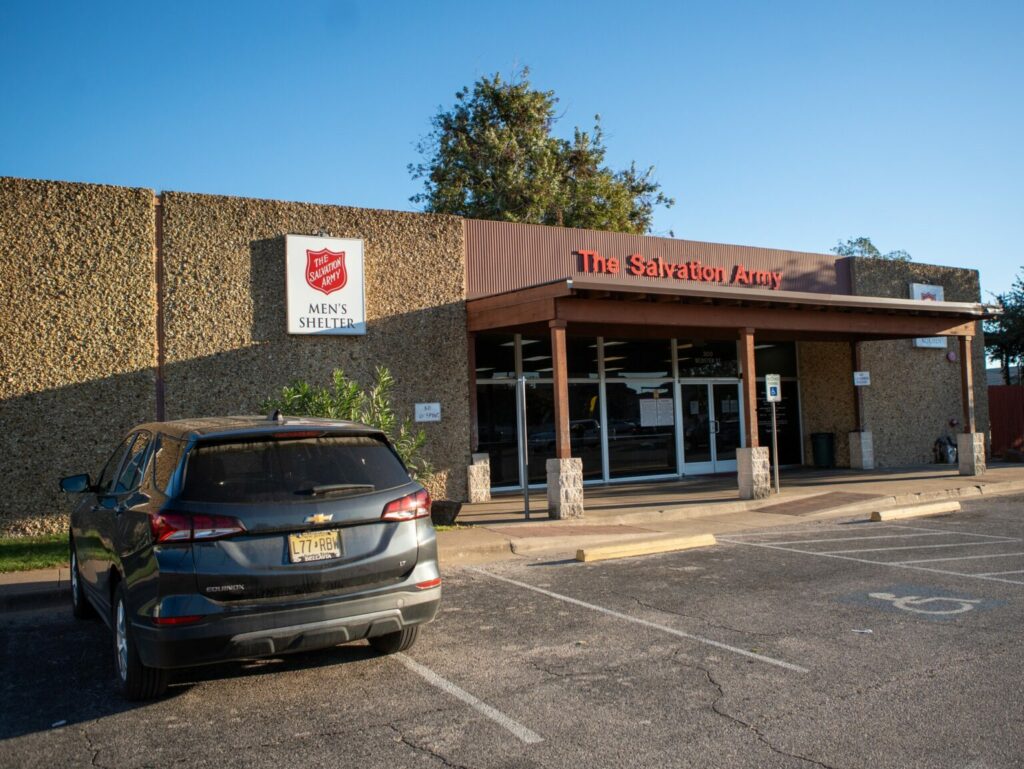
As we get closer to the holidays, my mind and heart naturally turn toward those in our community who are struggling. For many, this season brings joy, celebration, and family gatherings — but for others, it can be an especially difficult time marked by loneliness, instability, and need. Our local shelters, Sally’s House for women and children and the Men’s Shelter at the Salvation Army, work tirelessly all year long. But the Christmas season is always their busiest. More people seek warmth, safety, and support, and the demand for basic supplies grows quickly.
To help raise awareness and support both shelters, I’m sharing their current list of most-needed essentials.
These are simple, everyday items — things we often take for granted — but they make an enormous difference for someone trying to get back on their feet.
* Shampoo
* Conditioner
* Razors
* Hot chocolate
* Tea bags
* Honey
* Coffee
* Bottled water
* Socks
* Mittens
* Hats
*Hygiene Products
These donations directly support women, children, and men who rely on the shelters for warmth, hygiene, comfort, and care.If you’re local and able to help in any way, it would be so appreciated — not just by the staff and monitors, but by every person who receives these small acts of kindness. Every bottle of shampoo, every warm pair of socks, every cup of tea matters.Thank you all for any help you can give this holiday season. Together, we can make it a little brighter for those who need it most.
If you are experiencing homelessness and you would like to be assessed for available housing options in the Heart of Texas region, please call Heart to Home Coordinated Entry at 254-297-8929, or go to an access point to be assessed. Full resource page here: https://www.mclennan.gov/1190/Community-Resources

Debbie Wright is a Waco-based creative entrepreneur, digital storyteller, and community advocate dedicated to elevating local voices and arts culture. As the Digital Media Specialist for WACOAN Magazine and host of the Know Waco podcast, she spotlights the people, places, and stories that make Central Texas vibrant. Debbie is also the founder of Cultivate Waco, a mobile arts initiative bringing pop-up galleries, community events, and creative experiences to neighborhoods across the city. With a background in marketing, curation, and multimedia content creation, she blends her love for travel, art, and community connection into every project she touches.
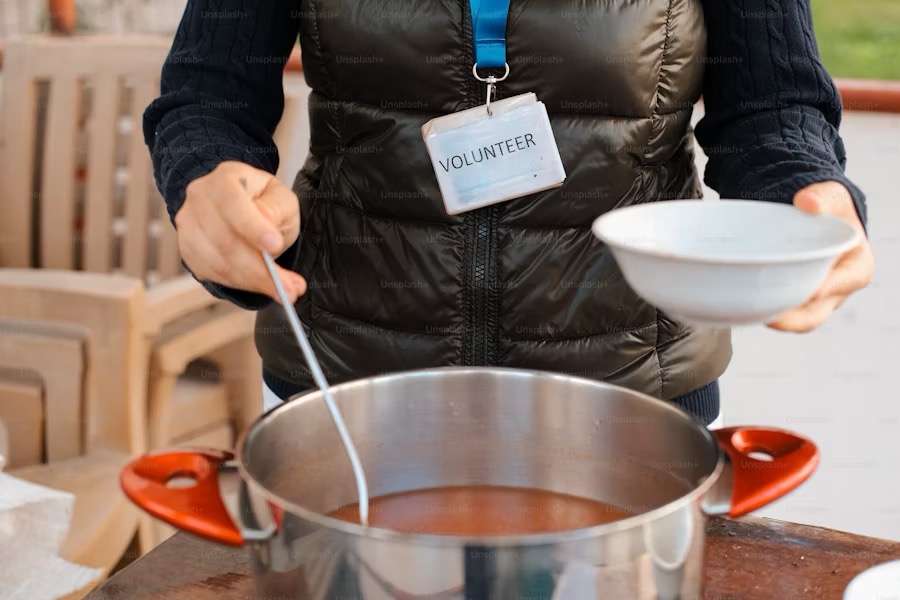
The season of thanks is in full swing, and as the day of joining and feasting approaches, we reflect and show gratitude for all that occurs for us. While it is easy to get caught up in the hustle of preparing meals, gathering with loved ones, and counting our blessings, this time is the perfect opportunity to give to those who may be struggling or in need. Volunteering during the Thanksgiving season is a unique way to experience gratitude and spread holiday cheer for others in our community. For ways to contribute your time and energy in Waco, here is a compiled list of volunteer opportunities searching for participants.
The Salvation Army is hosting Thanksgiving Lunch on November 28th from 10 a.m. through 2 p.m. at the Community Kitchen located at 300 Webster, Waco, TX 76706. While the first shift is already filled with eager volunteers, the second shift, working from noon to close, is still looking for several available contributors. Alongside the Thanksgiving Lunch, the Salvation Army will be hosting a Christmas Lunch on December 25th and continuing their Community Kitchen and Family Thrift Store volunteer opportunities.
Mission Waco will be hosting their annual Thanksgiving Lunch on November 28th from 12 p.m. to 1 p.m. at the First Methodist Church of Waco. They will be hosting chapel the half hour before lunch with an hour of BINGO following! They are seeking volunteers to help prepare turkeys ahead of time, such as cooking, deboning, separating meats, and to assist with food preparation on November 27th. For information on volunteering please email Bailie Rouse at [email protected].
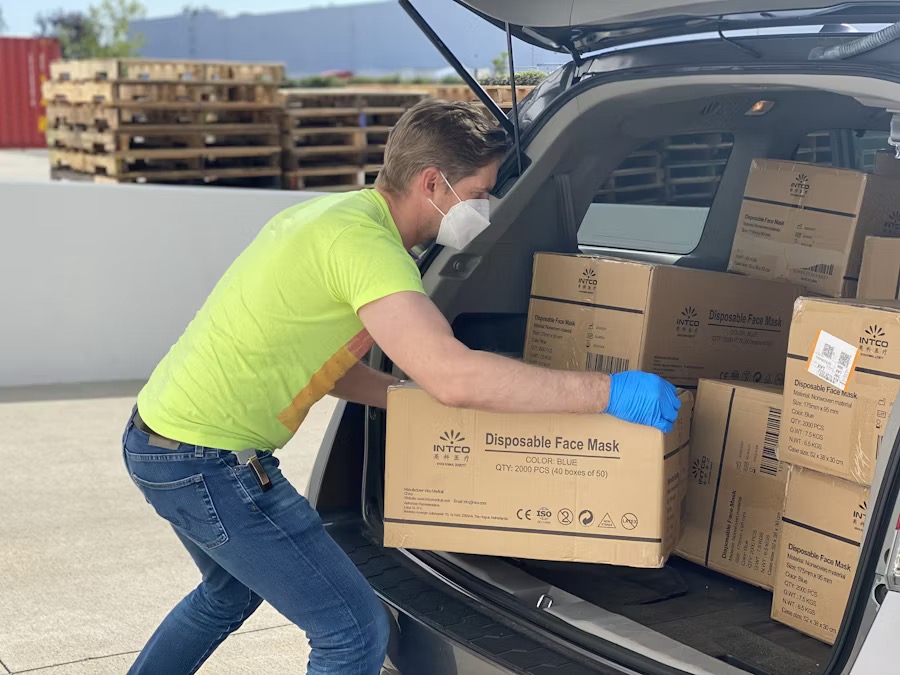
Food For Families is an annual project hosted by the Longhorn Council–Scouting America, H.E.B. Grocery Company, and KWTX News 10. With food pantries across Central Texas, this food drive collects non-perishable items and stocks the shelves of banks and pantries in our area beyond the holiday season. Join them on Friday, November 22nd for the 35th year of Food for Families. All food and monetary donations will benefit nine local food pantries. Their goal for this year is 550,000 pounds of food, and with your help, they will achieve that total! What’s Needed? Canned Meats, Tuna, Chili, Stew, Chicken, Canned Vegetables, Sugar, Corn Meal, Pasta, Pasta Sauce, Cereals, Flour, Peanut Butter, Dry Beans, Flour, Rice.
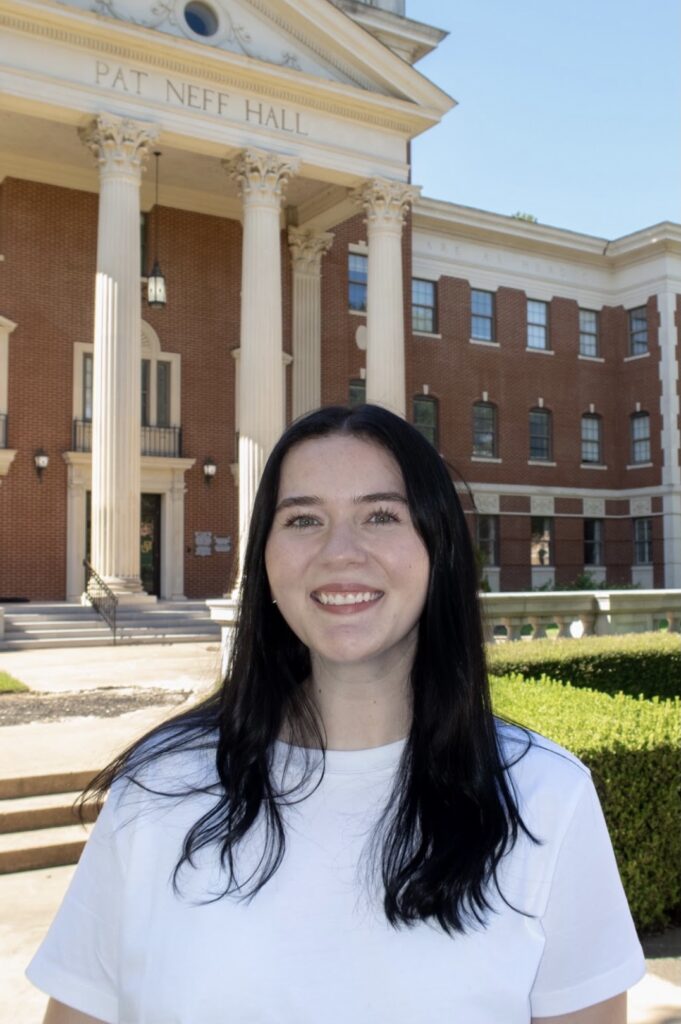
Elizabeth Riley hails from Tennessee and is a senior double majoring in English and Professional Writing & Rhetoric at Baylor University. She works as a Transcription Assistant at the Baylor University Institute for Oral History and is President of the Baylor Ice Girls for the 2024-2025 season.
On Monday afternoon, Waco Family Medicine (WFM) hosted “Flavor Feast,” a free lunch at the Meyer Center for community members experiencing homelessness. The event included a meal provided by Part Time Chef and a cooling station for attendees.

The event kicked off WFM’s recognition of National Health Center Week (NHCW). NHCW is an annual observance sponsored by the National Association of Community Health Centers (NACHC) running from Aug. 6 to 12. It aims to raise awareness and honor the contributions of Community Health Centers (CHCs) like WFM that provide comprehensive healthcare services to millions of patients across the U.S.
WFM’s NHCW programming includes People Experiencing Homelessness Day (Monday), Patient Appreciation Day (Wednesday), and Health Center Staff Appreciation Day (Friday). Patients and staff will be recognized with tokens of appreciation later in the week.
Each year for NHCW, WFM hosts Healthcare for People Experiencing Homelessness Day to highlight and expand the care provided to community members experiencing homelessness in Central Texas. People who experience homelessness endure higher rates of chronic and acute disease, behavioral health conditions, and other needs that are connected to poorer health outcomes, disability, and early death. Located downtown in the same building as Mission Waco’s Meyer Center, Waco Family Medicine – Meyer Center treats more patients experiencing homelessness than most other locations in the clinic system.

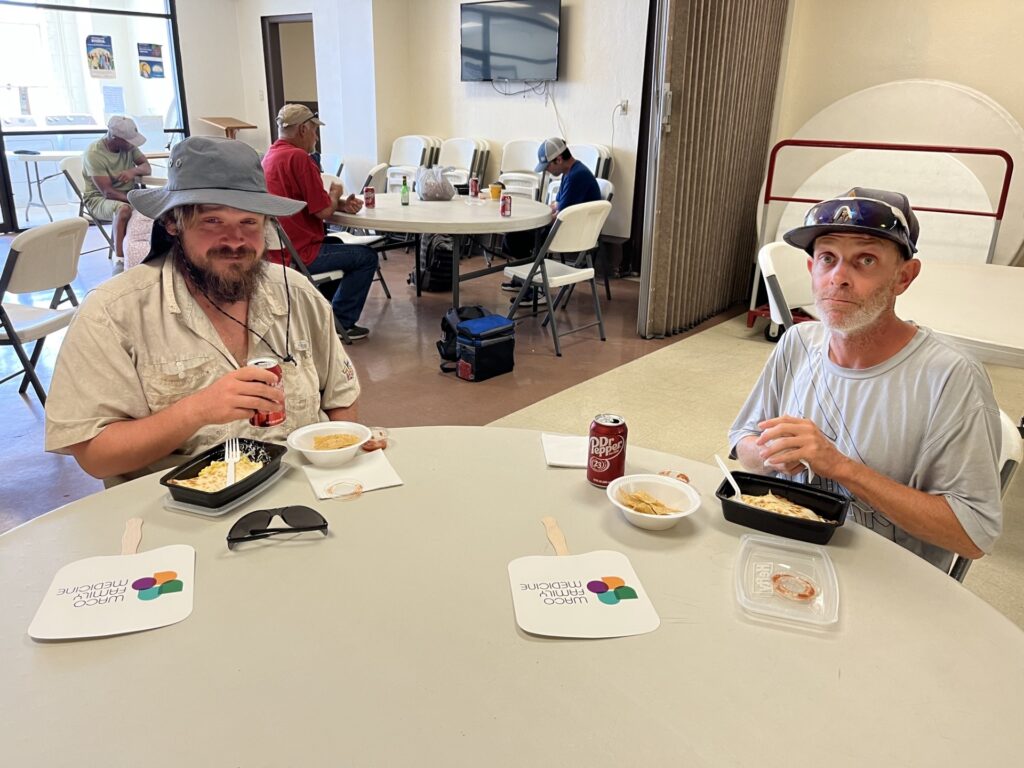
In 2022, WFM provided more than 61,000 patients with integrated medical, dental, and behavioral health care across 15 clinical sites. WFM addresses social and environmental barriers to wellness through innovative programs and community partnerships. Additionally, an in-house pharmacy provides quickly filled prescriptions to patients at a fraction of traditional costs.
With a quarter-million patient visits annually, the WFM system cares for one-fifth of McLennan County’s population. Ninety percent of county residents live within 10 miles of a WFM location, making care more accessible to patients, especially those with limited transportation. In 2021, about 74% of WFM patients identified as a racial or ethnic minority, and 22% were best served in a language other than English. The organization strives to provide high-quality, equitable care to meet the medical needs of Central Texans.
WFM invites community members, partners, and supporters to follow the organization on Facebook and Instagram (@wacofamilymedicine) to learn more about the social and economic contributions of CHCs throughout NHCW.
###
Waco Family Medicine is a Federally Qualified Health Center providing medical, dental, behavioral health, and community health care at 15 locations across McLennan and Bell counties. The nonprofit also provides graduate medical education through Waco Family Medicine – Institute and serves as a clinical training site for medical residency students, dental students, physician assistants, nurse practitioners, clinical social workers, pharmacy students, medical technicians, and allied health caregivers. WFM was established in 1970 to address a shortage of doctors, lack of access to primary healthcare, and economic development issues.
As much of Texas braces itself for several days of sub-freezing temperatures, the Salvation Army in Waco is working to help those experiencing homelessness and provide a warm, safe place to get out of the cold, not just at night, but during the day, too.
The Salvation Army shelter is at 300 Webster Ave. in downtown Waco. It provides overnight shelter for men, women, and families all year round. “On freezing cold days like this week we make arrangements for our building to be open and available during the day as a warming station so that people can come in off the streets and get warm,” said Major James Taylor of the Waco Salvation Army. “They don’t need to register to stay the night and there is no charge for any services at The Salvation Army. We just want those in need to be safe during this cold snap and for them to know that The Salvation Army is here for them.”
Salvation Army also makes plans to accommodate additional overnight guests when the weather is particularly cold. “It is inevitable that more people will come to us for assistance this week, especially seeking overnight shelter from the bitter cold,” said Taylor. “We make emergency beds available in our shelter during inclement weather, in addition to the beds available year-round, and will do our best to make sure everyone has a warm place to sleep. We currently have several people staying in our shelters, including men, women, and families.”
The annual Red Kettle Campaign ends on Christmas Eve and Salvation Army officers, staff, and volunteers are working hard to raise essential funds that make basic services including shelter, meals, and emergency financial assistance possible all year round here in Waco. “The practical, financial support of our community makes it possible for us to help those in need every day of the year, not just at Christmas,” said Major Taylor. “Your support means that The Salvation Army is there to keep the lights on for a family struggling to pay the bills, we can provide a hot meal and cup of coffee to a first responder working during times of disaster, and we can provide a warm, safe place for someone experiencing homelessness when temperatures drop below freezing.”
To make a donation, or for more information about the warming station and inclement weather shelter, please call Salvation Army at 254-756-7271, visit the online at Waco Corps (salvationarmy.org), or stop by at 4271 W. Waco Dr.
By Jeremy Rhodes
The first wave of data releases from the 2020 US Census is here, and many of the demographic shifts that we’ve seen across the country and the state are mirrored in our Waco community. In this series of posts, I am presenting some of the demographic changes we see in McLennan County from 2010 to 2020.
The first post presented numbers regarding general population growth and decline. The second post showed an overview of racial and ethnic changes in the county. The third post expanded on the racial/ethnic changes in McLennan County since 2010. In this post, we will look at some of the changes to the housing landscape in Waco since 2010.
This first map shows the number of housing units in each area, as well as the change in housing units since 2010. The orange areas saw a decline in total housing units, with darker shades indicating a larger decline. The green areas saw an increase in total housing units, with darker shades indicating a larger increase. The top number shows the total number of housing units in that area, while the bottom number shows the change in number of housing units since 2010.
Most of central Waco and north Waco saw little change in total number of housing units from 2010 to 2020. The largest growth in housing units was seen in China Spring, with an addition of 1131 housing units, and Hewitt, with an addition of 1,000 units. Only six census tracts saw declines in the number of housing units since 2010. One of the historic East Waco tracts (tract 15) saw the largest decline in housing units, with a loss of 141 households. Most of the county saw moderate to robust housing growth.

The second map is similar to the first. The coloring is the same, with green shades indicating growth in housing units since 2010, and orange shades indicating decline in housing units since 2010. The black number in each tract is different in this map; it displays the number of residents per household in that area. Most of the county has between two and three people per household. Notable exceptions include downtown Waco and historic East Waco, where there are fewer than two residents per housing unit.
There are two outlier tracts that should be explained. In the northwest of the map, you will see a tract with 17 people per household. That tract is the airport, and we should not think too much about housing and population data for that tract. The other outlier is the tract containing Baylor University, which has a “persons per household” of 149.6. Although the Census Bureau does not consider dorms to be housing units, I cannot be certain how they obtained such a high number while excluding dorms from consideration.
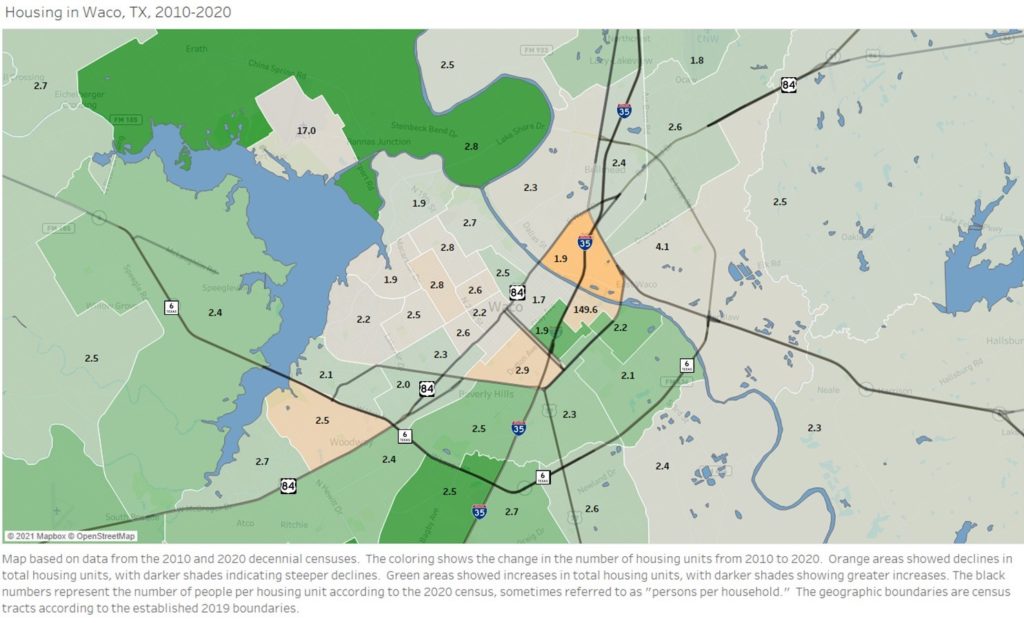
If you have any questions about this, or if you would like Jeremy to give an overview of these changes to your group, staff, or organization through Zoom or in person, please contact Jeremy Rhodes at [email protected].
Jeremy Rhodes, Ph.D., is director of research and community impact for Prosper Waco.
The Act Locally Waco blog publishes posts with a connection to these aspirations for Waco. If you are interested in writing for the Act Locally Waco Blog, please email Ferrell Foster at [email protected].

By Jeremy Rhodes
My family and I are trying to buy a house here in Waco. In case you haven’t heard, that’s hard to do right now. Luckily, we have some generous friends who are allowing us to crash at their place for a few weeks while we get things ironed out.
We have made an offer on seven houses. (I think?… My wife would know for sure.) For at least two of the houses, we know we were the highest bid, but we lost out to some cash offers.
The recent decision of our city council to limit short-term rentals should help the supply of housing for sale, but the impact of that change might not be felt for a while. For now, we are left at the mercy of sellers who we can only hope will see some value in our offers and take mercy on a family trying to finance their home.
Increasing home prices can have ripple effects on rental prices, as well. As my wife and I consider the possibility that we may have to rent for a few months and try to ride out this real estate wave, we are realizing that the cost of renting is rising along with the cost of buying. In some cases, the cost of renting is as high as the cost of a mortgage, but without the benefit of building equity on an asset.
I imagine this squeeze is being felt especially hard for first-time home buyers, especially those who are looking for low-cost homes to buy. About once or twice a week, I hear rumors of West-Coast investors paying cash to snatch up homes to flip, but I’m not sure how or whether those rumors can be verified. The current difficulty of our housing market has more to do with the current low supply of homes for sale than with a surplus of potential buyers.
So please sell me your house, but only if it’s a house I’ll like. We’re not currently in the market for houses we don’t like.

Jeremy Rhodes is director of research and community impact for Prosper Waco.
The Act Locally Waco blog publishes posts with a connection to these aspirations for Waco. If you are interested in writing for the Act Locally Waco Blog, please email Ferrell Foster at [email protected].
By Jimmy Dorrell
With the previously rumored and publicly unannounced closing of the Oak Lodge Motel, based on a desire “to make our city better,” those who live on the edges are about to lose even more access to affordable housing and will likely move into worse conditions. While I realize it is hard to defend this old, challenging motel complex (and other substandard hotels) due to its history, petty drugs, and crime, at this time in Waco there are almost no other choices for housing for hundreds of these “invisible homeless,” including some families with children. Some of those tenants are members of Church Under the Bridge, who attend weekly.
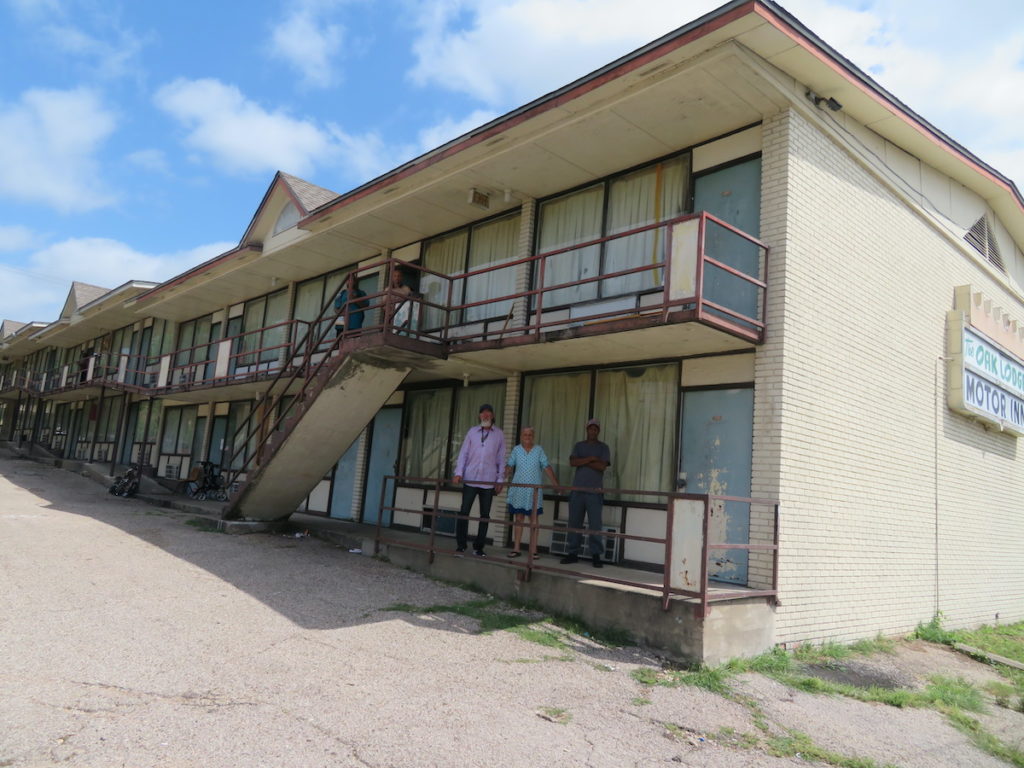
I know our city leaders and some community members care about the poor and may even acknowledge the growing lack of affordable housing in Waco for them. The lack of living wages at work in Waco contributes to their inability to rent housing. Most likely these discussions will not produce any viable answers for years that address the current and growing glut of options for Waco’s most vulnerable.
It is a crisis, not just a problem. It will only get worse for them in the months ahead.
While Church Under the Bridge has recently initiated a new ministry to focus more on that very population, we also have few housing resources to help. Our first ministry goal is to build deeper relationships with the families and individuals and walk with them through their current plight, yet we are realistic to know there are fewer resources that really address the bigger issues of housing them in Waco. It is a community problem that demands increased attention and even interim answers.
I challenge the churches and caring community to make every effort at your disposal to save these and create new housing options before they are evicted onto our streets. I also encourage you to discourage the removal of these who will be displaced until each of them has adequate housing.
Mohandas Gandhi said, “The greatness of a nation can be judged by how it treats its weakest members.” That goes for cities, as well.
We commit to pray for our leaders and local churches as you struggle with these challenging issues and for the poor!
Here are some articles that may help highlight the challenge in our community:
“The People Staying and Living In America’s Hotels” https://www.newyorker.com/culture/photo-booth/the-people-staying-and-living-in-americas-motels
“America’s Hidden Homeless”: https://www.aljazeera.com/features/2016/7/30/americas-hidden-homeless-life-in-the-starlight-motel

Jimmy Dorrell is pastor of Church Under the Bridge in Waco and founder of Mission Waco.
The Act Locally Waco blog publishes posts with a connection to these aspirations for Waco. If you are interested in writing for the Act Locally Waco Blog, please email Ferrell Foster at [email protected].
Editor: In honor of Women’s History Month, we are featuring interviews with local women leaders. These pieces were written by Baylor University students from the Department of Journalism, Public Relations, and New Media.
By Arden Huston
There are people in Waco who need a little more love, understanding, and compassion. It’s time we not only feel their pain but also be moved to help relieve it. We need to give the homeless a little more compassion.
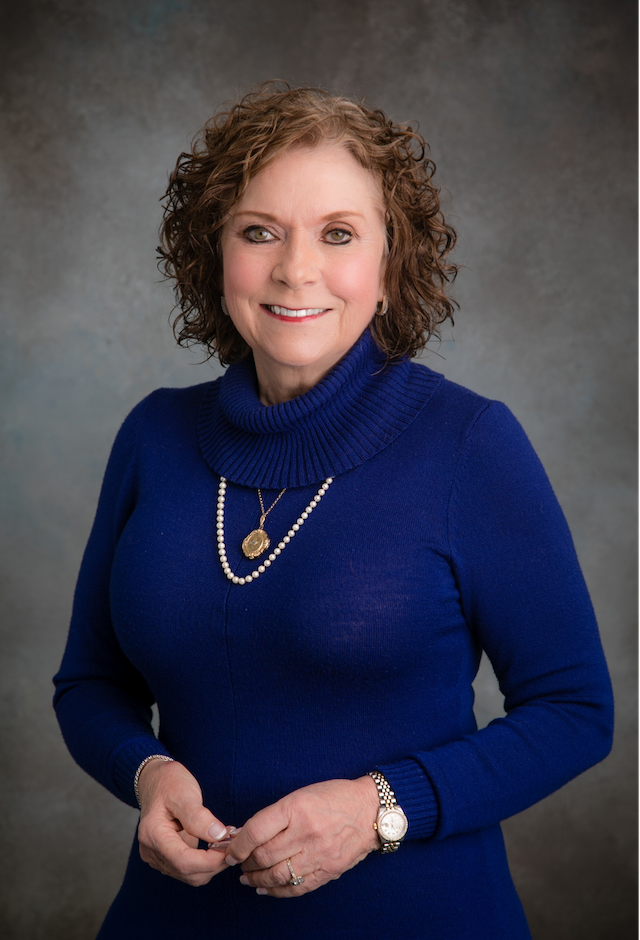
Compassion Waco is working to do that. Compassion is a transitional housing facility for homeless families with children where families can stay up to six months or a year until they learn effective ways to live on their own.
“I don’t know that I had a passion for Compassion when I came, because my image of the homeless was the guy on the street corner who needs a bath and a shave. But I now understand who we serve here is not necessarily that demographic,” Jill McCall, executive director of Compassion Waco, said.
Compassion Waco focuses on serving a specific demographic, which includes families and children. McCall mentioned how it’s important to consider the average age of the homeless in the United States today is 11 and 57% of the homeless are women and children.
“There certainly are those guys on the end of the street corner, but they’re not the majority of the homeless, and they’re not the homeless we serve here in Waco” at Compassion, McCall said.
McCall also shared that her father died when she was 4 and her mother had three kids to take care of. At the time, her mother was lucky enough to have the support of an extended family that was able to assist her emotionally and financially.
Then one day it hit her. “I could have been a child of Compassion, had my mother not had those things and had there been a Compassion, because there wasn’t one then,” McCall said.
When you put things into perspective in this way it’s easier to sympathize with the homeless. The reason many people become homeless is because of a lack of support and financial understanding.
“I think we all can agree most of us get out of high school or college and most of the time we haven’t been very accountable with our money. I mean we’ve never been made to be,” McCall said.
This is a common reason for homelessness. People that come to Compassion often haven’t had anyone to teach them how to budget their money, and they come to learn just that.
“People have to want the help; they have to be at that point in their lives where they’re ready to accept that help. Sometimes people are too proud to accept it,” McCall said.
Compassion has a variety of volunteer opportunities for people who want to help, especially those who like working with kids. They are always in need of people to provide after school care and monitor the children in the computer room.
McCall mentioned a challenge of the job is not being able to see the people while they’re on the other side of things, when they’ve gotten their lives together and aren’t in need of help anymore.
She cites a popular proverb of uncertain origin. “We are planting trees knowing full well, we will never see the shade,” McCall said. “That, on the other hand, says the shade will come. We may not see it, but that’s not what’s important. What’s important is that they find the shade.”

Arden Huston is a sophomore at Baylor University from Houston double majoring in psychology and professional writing.
The Act Locally Waco blog publishes posts with a connection to these aspirations for Waco. If you are interested in writing for the Act Locally Waco Blog, please email Ferrell Foster at [email protected].
by Phil York, Act Locally Waco Housing and Homelessness Policy blogger
Since the post-holiday season, we have used the motif of unwrapping gifts to understand some of the dimensions of housing and homelessness.
We started our discussion with a definition of homelessness through Housing and Urban Development (the federal agency that administers national housing programs). We then discussed how this definition is applied to children, veterans and our other neighbors who may not have a home.
The purpose of our conversation is to keep us all informed: we need to be aware of how decisions made in Washington affect our lives in Waco.
We can use the lessons learned over the past few months and apply them to the latest update from Washington. Let us use our knowledge-base to unwrap:
- The basics of the proposed legislation
- Possible local implications of the proposed legislation
- Ways we can continue our collective efforts to build a stronger Waco
The Basics of the Proposed Legislation:
The U.S. House of Representatives Fiscal Year 2015 Transportation, Housing and Urban Development (THUD) bill is scheduled for House Appropriations Mark-up next week.
Here are the basics about the bill (a paraphrased summary provided by CSH – A Housing Policy and Advocacy Group (www.csh.org )):
- Overall, the House version of the FY2015 THUD Appropriations bill would decrease funding for HUD by $769 million from the FY2014 levels.
- The bill flat funds the Homelessness Assistance Grant programs, providing $2.1 billion. It did not accept the $300 million increase proposed by President Obama.
- There is a slight increase in Housing Choice Voucher program; however, the funding provided does not restore the 40,000 vouchers that were lost to sequestration.
- Funding for the HOME program cut by $300 million.
The U.S. House of Representatives Committee reports specifically about the Community Planning and Development program with the following update in a May press release:
“The bill contains $6.2 billion for Community Planning and Development programs – a reduction of $383 million below the fiscal year 2014 enacted level. The Community Development Block Grant formula program is funded at $3 billion – effectively equal to last year’s level – while the HOME Investment Partnerships Program is funded at $700 million, a reduction of $300 million below the fiscal year 2014 enacted level.
Subcommittee Chairman Tom Latham provided the following commentary about the proposed bill:
“My priorities in this process were to act in a bipartisan fashion to fund our most vital programs with our critical need to reduce the deficit. This is a sound, commonsense bill that meets our highest transportation and housing priorities in a fiscally responsible way. I look forward to working with my colleagues on both sides of the aisle to move this important legislation forward in an open legislative process.”
Possible Local Implications of the Proposed Legislation:
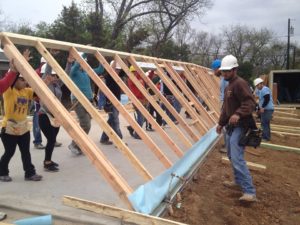 Waco Habitat is just one of many organizations that partner with the City of Waco to build a stronger Waco with the programs described above. Here are a few ways Waco Habitat used these precious public dollars to improve our community:
Waco Habitat is just one of many organizations that partner with the City of Waco to build a stronger Waco with the programs described above. Here are a few ways Waco Habitat used these precious public dollars to improve our community:
ReStore:
- By using Community Development Block Grant (CDBG) funds through a zero percent loan (that was paid back within three years), the Waco economy has been greatly impacted for the good.
- ReStore offers affordable building materials to people in our community, recycles products thus diverting them from the landfill, and supports administrative efforts of our organization.
- ReStore diverts 3,000 tons from the landfill annually and saves the city about $164,000. The net income from ReStore assures donors to Waco Habitat that 100% of their gift goes to build and repair homes in our community.
New Home Construction Program:
- We are concerned that funding levels proposed in the FY 2015 House THUD bill will make it more difficult for us to serve people living at 30% to 60% area median family income.
- Without HOME funds our partnership housing ministry would be greatly thwarted. Since 1999, Waco Habitat for Humanity has served as a Community Housing Development Organization.
- With over $3.1 million, we have built 48 houses.
- Home ownership assures about seven new home owners join the tax paying roles each year.
- Home ownership adds to the tax base of our community, improves schools, enhances professional opportunities, strengthens school performance, expands likelihood of graduation, and spreads hope for future generations.
Habitat achieved the above accomplishments thanks to our public fund partnerships. Budget cuts today affect Waco’s ability to realize a community where everyone has a decent place to live.
Ways We Can Continue Our Collective Efforts to Build a Stronger Waco:
- Remain informed: The most important call to action is for us to remain informed about the current policy landscape. Regardless of your political background or interest, we share common ground in the preservation and long term health of Waco. Follow the work of the US Committee on Appropriations: http://appropriations.house.gov/news/.
- Have your voice heard: Contact your U.S. House representative. Please provide your Representative with the talking points provided above. If your Representative is Mr. Bill Flores, you have the convenience to contact Rep Bill Flores directly via email (https://billflores.house.gov/contact/ ).
- Connect directly to the mission: There are volunteer opportunities at Habitat and other nonprofit organizations that work directly with our neighbors in need. These organizations offer opportunities for you to give of your time and talent.
Your donations, whether they be of time or money, are important – they bind us together. Once connected, we may share the urgency of the above implications and collectively move our leadership to join us as we build a stronger Waco together.
 Phil York, Director of Development at Waco Habitat for Humanity, is a self-described “policy nerd;” he is also the Act Locally Waco housing and homelessness policy blogger. You can direct questions to Phil to [email protected]. Would you be interested in blogging for Act Locally Waco? If so please email [email protected].
Phil York, Director of Development at Waco Habitat for Humanity, is a self-described “policy nerd;” he is also the Act Locally Waco housing and homelessness policy blogger. You can direct questions to Phil to [email protected]. Would you be interested in blogging for Act Locally Waco? If so please email [email protected].

